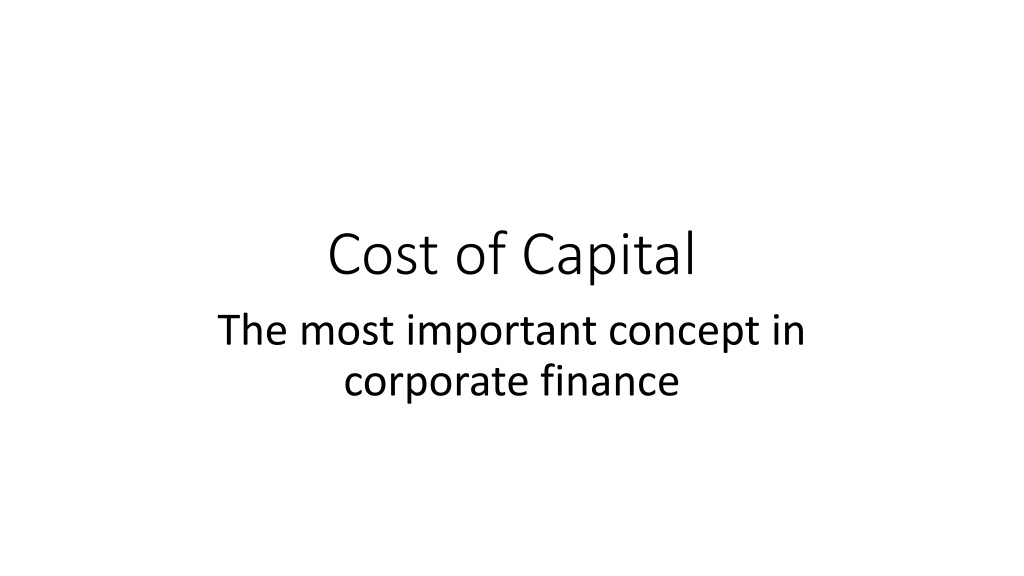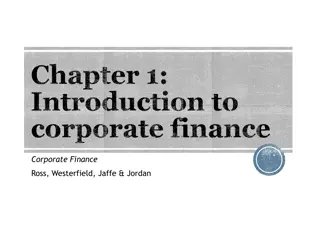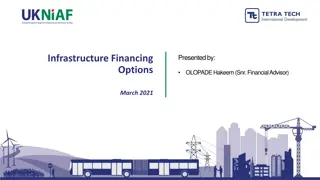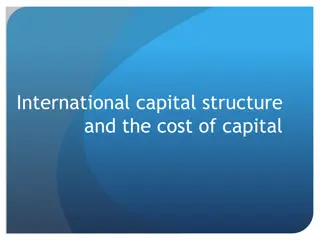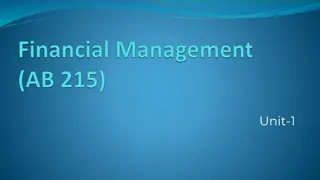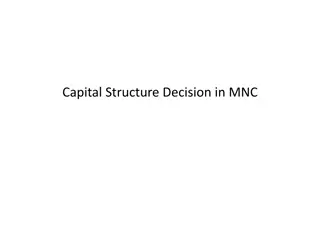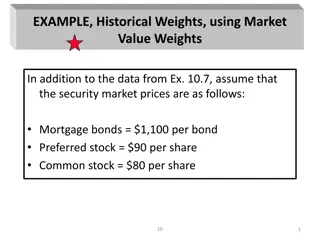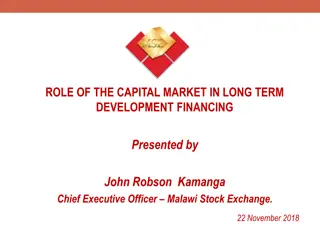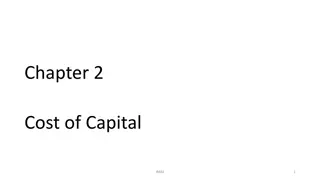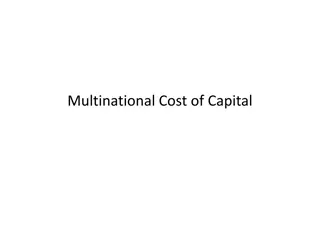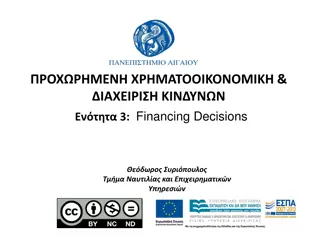Understanding the Significance of Cost of Capital in Corporate Finance
Cost of capital is a fundamental concept in corporate finance introduced by Modigliani and Miller in 1958. It involves calculating the Weighted Average Cost of Capital (WACC) as a combination of debt and equity costs to determine asset value. Despite discrepancies in calculating asset values, WACC remains a key metric for valuation. This concept raises questions about the applicability of linear combinations for nonlinear factors, prompting a deeper examination of cash flow assumptions and investment financing.
Download Presentation

Please find below an Image/Link to download the presentation.
The content on the website is provided AS IS for your information and personal use only. It may not be sold, licensed, or shared on other websites without obtaining consent from the author. Download presentation by click this link. If you encounter any issues during the download, it is possible that the publisher has removed the file from their server.
E N D
Presentation Transcript
Cost of Capital The most important concept in corporate finance
The theory of corporate finance was established in 1958 by Modigliani and Miller. They published a paper called The cost of capital, corporation finance and the theory of investment. In that paper, they derive the mathematical formula for the cost of capital as a linear combination of cost of debt and cost of equity. It is called Weighted Average Cost of Capital (WACC).
It provides a new way to compute asset value. Asset value can be calculated as the sum of expected cashflows discounted by the cost of capital (WACC) Asset value is also the sum of equity and debt. If the Modigliani Miller theory is correct, two methods to calculate asset value should yield the same result.
However, different methods of computing asset values often provide different answers. This is usually attributed to oversimplifications in cashflows. If this is really the case, we can calibrate the cashflows so different methods will yield the same answer. However, differences persist. We can also examine numerical examples where cashflows are very simple. Differences persist.
Some intuition WACC is a linear combination of two (or more) discount rate. Discounting is a nonlinear factor. Would linear combination work for nonlinear factor? This is a puzzle. Let s check the original paper by Modigliani and Miller.
The original paper by Modigliani and Miller In the original 1958 paper, cashflows were assume to be constant to perpetuity. What happens to more general cashflows? We will try to find out.
1. An example Your investment is valued at 1000 dollar. You borrow 300 hundred dollar from a bank (or from the capital market) to finance the investment. The bank owns 300 dollar of your investment. You, as the equity owner, own the rest, 700 dollar. The value of the total investment, 1000 dollar, is the sum of equity, 700 dollar and debt, 300 dollar.
Debt owners have priority to receive cashflows from the investment. The equity owners receive the residual cashflows. Risk of dividend payments for the equity is higher than the risk of coupon payments for the debts. As a result. Expected returns from equity is higher than the expected return from the debt to compensate for the higher risk. Suppose the interest rate of the debt is 4% per year. The cost of debt is 4% per year. The dividend yield for the equity owner is expected to be 8% per year to perpetuity. The cost of equity is 8% per year.
The cashflows to debt owners and equity owners are separate. The discount rates of debts and equities are different. But we can also think the total cashflows from the investment as a whole. It would be nice to have a single discount rate for the total cashflows. What would be the discount rate for the total cashflow?
Modigliani and Miller theory provides the answer to this question. It is the theoretical foundation of corporate finance. In this class, we will explore this question and its answer.
2. Cost of Capital: An Introduction Investment assets are generally financed with equity and debt. The value of an asset is the sum of its equity and debt. Equity and debt can be valued separately. They are valued with equity and debt cashflows discounted by equity discount rate and debt discount rate, respectively. When equity and debt of a company are publicly traded, we can observe the market values of equity and debt of a company.
An asset can also be valued directly with the total cashflows of the asset discounted by a single discount rate. In finance theory, this discount rate is called WACC (Weighted Average Cost of Capital).
WACC (Weighted Average Cost of Capital): Definition (1 of 2) Suppose V is the value of whole investment asset. S is its equity(stock) value. D is its debt value. Then ? = ? + ? The sum of the values of equity and debt is equal to the value of the whole investment asset.
WACC (Weighted Average Cost of Capital): Definition (2 of 2) ? is the discount rate of the debt cashflows. ??is the discount rate of the equity cashflows. ? is the discount rate of the total asset cashflows. Then ? ? ? = ?+?? + ?+??? This is the formula for WACC (Weighted Average Cost of Capital).
Modigliani and Miller theory introduces a new method to value investment assets. It values an investment asset by summing all cashflows with a single discount rate: WACC. Previously, assets can be valued as the sum of equity and debt. If the new method from MM theory is correct, two methods should yield the same result. Do they? We will look at some numerical examples first. Then we will make theoretical derivation.
3. Numerical examples We will calculate asset values of investments with some numerical examples. This will help us gain more intuition. With numerical method, we can also calculate varies cashflows and capital structures with ease.
Debt owners get the first claims on the asset. Their cashflows are safer than that of equity owners. As a result, discount rates on debts are lower than the discount rates on equities for the same assets.
The formula for calculating bond value The bond has principal of P, coupon of d. It matures in n years. The discount rate is r. The value of bond is represented by the following formula ? =? ?1 1+?? + 1+?? 1 ? The value of bond is a nonlinear and complicated function of r. This suggests that the cost of capital may not be a simple linear combination of equity and debt discount rates.
Example 1 A company will distribute 3 million dollar coupon to bond holders each year. The principal of the bond is 100 million. The bond matures in ten years. The company is expected to distribute 3 million dollar dividend to equity holders next year. Assume the growth rate of the dividend is 0% per year. The market value of the bond is 100 million dollar and the market value of the equity is 60 million dollar.
What is the cost of equity? What is the cost of debt? What is WACC? What is asset value calculated from discounting by WACC? What is the asset value as the sum of debt and equity? Are two values the same?
Solution The bond price is equal to its par value. The cost of bond is the amount of coupon divided by its principle. It is 3/100 = 3% The dividend yield of equity is dividend divided by its market value, 3/60 = 5%
The cost of equity is Dividend yield + growth rate = 5%+0%=5% WACC = 100/(100+60)*3% + 60/(100+60)*5% = 3.75%
Asset value according to WACC Asset value = debt value + equity value 3 1+3.75%?+ = 3.75%1 1+3.75%10 = 173.84 100 3 10 = ( ?=1 1+3.75%10) + ?=1 1+3.75%? 3 3.75% 3 1 100 + 1+3.75%10+
The sum of debt and equity is 100+60 = 160 Million So the asset value calculated from WACC is 173.84/160 = 1.0865 times the value of debt plus equity. What is the problem here? We need to assume debt will be rolled over to perpetuity.
Asset valuation by WACC with debt roll over With debt rollover, cashflows from debts will be 3 million dollar per year to perpetuity. Total cashflows from the asset per year is 3 + 3 = 6 million dollar per year. The asset value measured by free cashflows discounted by WACC is 3+3 6 ?=1 1+3.75%?= 3.75%= 160 This is the same as the sum of equity and debt.
Observation In this example, we can extend the maturity date to 20 , 40 years. As maturity date longer, the asset value from discounting by WACC approaches to the sum of debt and equity.
Example 2 A company will distribute coupon amount to 3 million dollar to bond holders and dividend amount to 3 million dollars to equity holders next year. The perpetual bond has a peculiar arrangement. Its coupon rate increases 2% every year. The market value of the perpetual bond is 100 million dollars and the market value of the equity is 50 million dollars. Assume the growth rate of the dividend is 2% per year.
What is the cost of equity? What is the cost of debt? What is WACC? What is asset value calculated from discounting by WACC? What is the asset value as the sum of debt and equity? Are these two values the same?
Solution Suppose the cost of bond is r. The value of the bond is 3/(r 2%) = 100 We solve the equation to get r = 5% The dividend yield of equity is 3/50 = 6% The cost of equity Dividend yield + growth rate = 6%+2%=8% WACC = 100/(100+50)*5% + 50/(100+50)*8% = 6%
Asset value according to WACC 3 1+2%? 1+3 1+2%? 1 1+6%? ?=1 6 1 + 2%? 1 1 + 6%? = ?=1 6 = 6% 2%= 150
The sum of debt and equity is 100+50 = 150 So the asset value calculated from WACC is 150/150 = 1 times the value of debt plus equity. When the growth rates of coupon payment and dividend payment are the same, asset value measured by free cashflows discounted with WACC gives the same answer as the sum of equity and debt.
Observation We can change the increase rate of coupon and dividend. As long as the level of increase rate (or decrease rate) is the same, discounting by WACC yield the correct answer.
Example 3 A company will distribute coupon amount to 3 million dollar to bond holders and dividend amount to 3 million dollars to equity holders next year. The market value of the perpetual bond is 100 million dollars and the market value of the equity is 100 million dollars as well. Assume the growth rate of the dividend is 4% per year.
What is the cost of equity? What is the cost of debt? What is WACC? What is asset value calculated from discounting by WACC? What is the asset value as the sum of debt and equity? Are two results the same?
Solution The cost of bond is 3/100 = 3% The dividend yield of equity is 3/100 = 3% The cost of equity Dividend yield + growth rate = 3%+4%=7% WACC = 100/(100+100)*3% + 100/(100+100)*7% = 5%
Asset value according to WACC 3+3 1+4%? 1 1+5%? ?=1 3 1 + 4%? 1 1 + 5%? 3 = 1 + 5%?+ ?=1 ?=1 3 3 = 5%+ 5% 4%= 60 + 300 = 360
The sum of debt and equity is 100+100 = 200 So the asset value calculated from WACC is 360/200 = 1.8 times the value of debt plus equity. WACC overvalue asset for growth firms.
Observation We can change the increase rate of dividend payout. What results do we observe?
Example 4 A company will distribute coupon amount to 3 million dollar to bond holders and dividend amount to 4 million dollars to equity holders next year. The market value of the perpetual bond is 100 million dollars and the market value of the equity is 50 million dollars. Assume the growth rate of the dividend is -2% per year.
What is the cost of equity? What is the cost of debt? What is WACC? What is asset value calculated from discounting by WACC? What is the asset value as the sum of debt and equity? Are two results the same?
Solution The cost of bond is 3/100 = 3% The dividend yield of equity is 4/50 = 8% The cost of equity Dividend yield + growth rate = 8%-2%=6% WACC = 100/(100+50)*3% + 50/(100+50)*6% = 4%
Asset value according to WACC 3+4 1 2%? 1 1+4%? ?=1 4 1 2%? 1 1 + 4%? 3 = 1 + 4%?+ ?=1 ?=1 3 4 = 4%+ 4% ( 2%)= 300/4 + 400/6 = 141.7
The sum of debt and equity is 100+50 = 150 So the asset value calculated from WACC is 141.7/150 = 17/18 times the value of debt plus equity. WACC undervalue assets for declining firms.
Observation We can change the decrease rate of dividend payout. What results do we observe?
Example 5: equity valuation of corporations experiencing different stages of life cycle Suppose the expected dividend of a company is 2 million next year. The dividend is expected to grow 15% per year for four years until year five. Then the expected annual dividend growth is 3% to perpetuity. The market value of the company s equity is 60 million.
The company also issued a bond with principal of 30 million dollars. The coupon rate of the bond is 4% and the market value of the bond is 30 million dollars.
Cost of equity The equity discount rate, ??, implied from the market price of the equity, can be calculated from ?? ?? ?? 5 1+???= ?=1 ?=1 1+???+ ?=6 1+??? 1+?15 1+??5+ ?1 ?6 1 = 1 1+??5= 60 ?? ?1 ?? ?2
Here ?1= 15%,?2= 3%,?1= 2,?6= 2 1.154 1.03 = 3.6. From the equation in the last page, we calculate ??to be 7.96%.
Calculating WACC With debt yield of 4%, ? ? 30 60 ???? = ?+???+ ?+???= 30+604% + 30+607.96% = 6.64%
The value of equity cashflows discounted by WACC ?? ?? ?? 5 1+?????= ?=1 ?=1 1+?????+ ?=6 1+????? 1+?15 1+????5+ ?1 ?6 1 = 1 1+????5= 82.64 ???? ?1 ???? ?2
